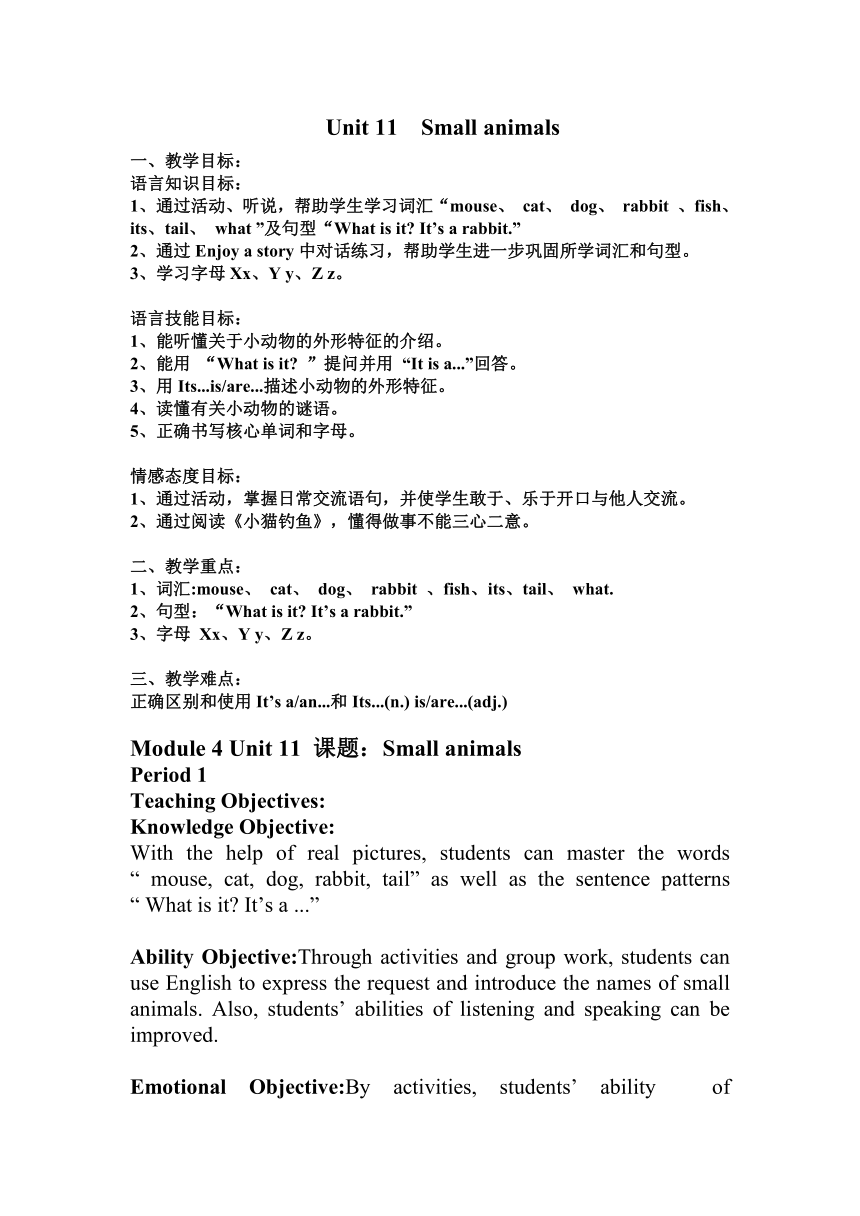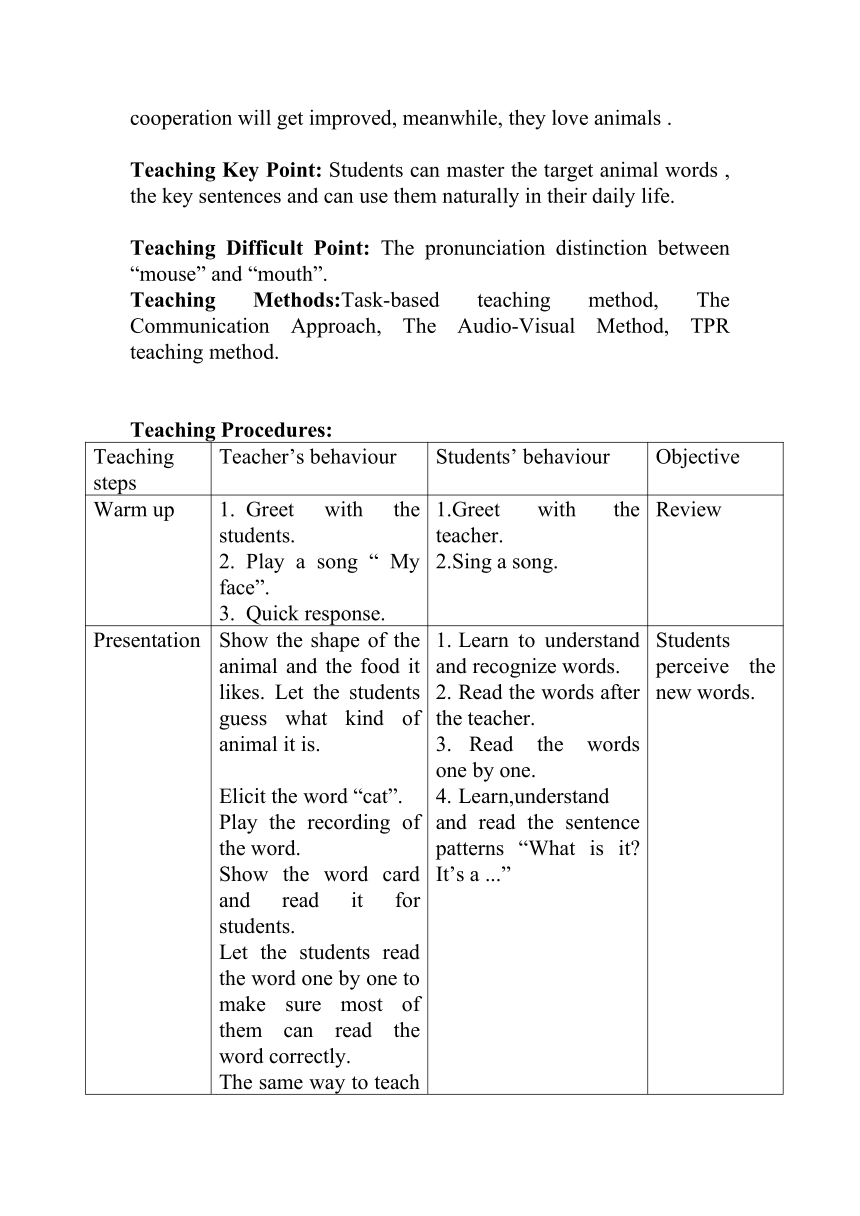Module 4 Unit 11 Small animals 表格式教案
文档属性
| 名称 | Module 4 Unit 11 Small animals 表格式教案 |  | |
| 格式 | doc | ||
| 文件大小 | 37.5KB | ||
| 资源类型 | 教案 | ||
| 版本资源 | 牛津沪教版 | ||
| 科目 | 英语 | ||
| 更新时间 | 2022-11-19 09:33:39 | ||
图片预览


文档简介
Unit 11 Small animals
1、教学目标:
语言知识目标:
1、通过活动、听说,帮助学生学习词汇“mouse、 cat、 dog、 rabbit 、fish、its、tail、 what ”及句型“What is it It’s a rabbit.”
2、通过Enjoy a story中对话练习,帮助学生进一步巩固所学词汇和句型。
3、学习字母Xx、Y y、Z z。
语言技能目标:
1、能听懂关于小动物的外形特征的介绍。
2、能用 “What is it ”提问并用 “It is a...”回答。
3、用Its...is/are...描述小动物的外形特征。
4、读懂有关小动物的谜语。
5、正确书写核心单词和字母。
情感态度目标:
1、通过活动,掌握日常交流语句,并使学生敢于、乐于开口与他人交流。
2、通过阅读《小猫钓鱼》,懂得做事不能三心二意。
二、教学重点:
1、词汇:mouse、 cat、 dog、 rabbit 、fish、its、tail、 what.
2、句型:“What is it It’s a rabbit.”
3、字母 Xx、Y y、Z z。
三、教学难点:
正确区别和使用It’s a/an...和Its...(n.) is/are...(adj.)
Module 4 Unit 11 课题:Small animals
Period 1
Teaching Objectives:
Knowledge Objective:
With the help of real pictures, students can master the words “ mouse, cat, dog, rabbit, tail” as well as the sentence patterns “ What is it It’s a ...”
Ability Objective:Through activities and group work, students can use English to express the request and introduce the names of small animals. Also, students’ abilities of listening and speaking can be improved.
Emotional Objective:By activities, students’ ability of cooperation will get improved, meanwhile, they love animals .
Teaching Key Point: Students can master the target animal words , the key sentences and can use them naturally in their daily life.
Teaching Difficult Point: The pronunciation distinction between “mouse” and “mouth”.
Teaching Methods:Task-based teaching method, The Communication Approach, The Audio-Visual Method, TPR teaching method.
Teaching Procedures:
Teaching steps Teacher’s behaviour Students’ behaviour Objective
Warm up Greet with the students.Play a song “ My face”. Quick response. 1.Greet with the teacher.2.Sing a song. Review
Presentation Show the shape of the animal and the food it likes. Let the students guess what kind of animal it is. Elicit the word “cat”.Play the recording of the word.Show the word card and read it for students. Let the students read the word one by one to make sure most of them can read the word correctly.The same way to teach other animal words “rabbit, cat, mouse”. When reading a word, pay attention to emphasize a pronunciation the same sound “/ /” / /,/ /,cat / /,/ /,rabbit.Read the words in a loud and low voice.Play the sound of the animal in turn. Elicit the target sentence patterns “What is it It’s a...” with “What can you hear ”.Explain the meanings of sentence patterns a little bit. Learn to understand and recognize words. Read the words after the teacher. Read the words one by one. Learn,understand and read the sentence patterns “What is it It’s a ...” Students perceive the new words.
Practice Let’s chant:What is it Cat, cat,cat. It’s a cat.... Students clap their hands rhythmically and chant together.
Production Group work:Riddles (Work in group of 4)Introduce an animal by its shape then ask and answer questions using the key patterns.
Consolidation Show the animal pictures and sentence patterns and let the students complete the dialogue in pairs.Emotional education: The teacher points at the animals and asks “Are they our friends ” to guide the students to take care of small animals. Students can master the sentence patterns “What is it It is a...” and can use them naturally in their daily life.
Summary The students summarize what they have learned in the class and the teacher comments students’ performance and then give a further summary.
Board plan
Small animals
----What is it mouse
----It’s a_______. cat
dog
rabbit
1、教学目标:
语言知识目标:
1、通过活动、听说,帮助学生学习词汇“mouse、 cat、 dog、 rabbit 、fish、its、tail、 what ”及句型“What is it It’s a rabbit.”
2、通过Enjoy a story中对话练习,帮助学生进一步巩固所学词汇和句型。
3、学习字母Xx、Y y、Z z。
语言技能目标:
1、能听懂关于小动物的外形特征的介绍。
2、能用 “What is it ”提问并用 “It is a...”回答。
3、用Its...is/are...描述小动物的外形特征。
4、读懂有关小动物的谜语。
5、正确书写核心单词和字母。
情感态度目标:
1、通过活动,掌握日常交流语句,并使学生敢于、乐于开口与他人交流。
2、通过阅读《小猫钓鱼》,懂得做事不能三心二意。
二、教学重点:
1、词汇:mouse、 cat、 dog、 rabbit 、fish、its、tail、 what.
2、句型:“What is it It’s a rabbit.”
3、字母 Xx、Y y、Z z。
三、教学难点:
正确区别和使用It’s a/an...和Its...(n.) is/are...(adj.)
Module 4 Unit 11 课题:Small animals
Period 1
Teaching Objectives:
Knowledge Objective:
With the help of real pictures, students can master the words “ mouse, cat, dog, rabbit, tail” as well as the sentence patterns “ What is it It’s a ...”
Ability Objective:Through activities and group work, students can use English to express the request and introduce the names of small animals. Also, students’ abilities of listening and speaking can be improved.
Emotional Objective:By activities, students’ ability of cooperation will get improved, meanwhile, they love animals .
Teaching Key Point: Students can master the target animal words , the key sentences and can use them naturally in their daily life.
Teaching Difficult Point: The pronunciation distinction between “mouse” and “mouth”.
Teaching Methods:Task-based teaching method, The Communication Approach, The Audio-Visual Method, TPR teaching method.
Teaching Procedures:
Teaching steps Teacher’s behaviour Students’ behaviour Objective
Warm up Greet with the students.Play a song “ My face”. Quick response. 1.Greet with the teacher.2.Sing a song. Review
Presentation Show the shape of the animal and the food it likes. Let the students guess what kind of animal it is. Elicit the word “cat”.Play the recording of the word.Show the word card and read it for students. Let the students read the word one by one to make sure most of them can read the word correctly.The same way to teach other animal words “rabbit, cat, mouse”. When reading a word, pay attention to emphasize a pronunciation the same sound “/ /” / /,/ /,cat / /,/ /,rabbit.Read the words in a loud and low voice.Play the sound of the animal in turn. Elicit the target sentence patterns “What is it It’s a...” with “What can you hear ”.Explain the meanings of sentence patterns a little bit. Learn to understand and recognize words. Read the words after the teacher. Read the words one by one. Learn,understand and read the sentence patterns “What is it It’s a ...” Students perceive the new words.
Practice Let’s chant:What is it Cat, cat,cat. It’s a cat.... Students clap their hands rhythmically and chant together.
Production Group work:Riddles (Work in group of 4)Introduce an animal by its shape then ask and answer questions using the key patterns.
Consolidation Show the animal pictures and sentence patterns and let the students complete the dialogue in pairs.Emotional education: The teacher points at the animals and asks “Are they our friends ” to guide the students to take care of small animals. Students can master the sentence patterns “What is it It is a...” and can use them naturally in their daily life.
Summary The students summarize what they have learned in the class and the teacher comments students’ performance and then give a further summary.
Board plan
Small animals
----What is it mouse
----It’s a_______. cat
dog
rabbit
同课章节目录
- Module 1 Getting to know you
- Unit 1 Hello!
- Unit 2 How are you?
- Unit 3 Are you Kitty?
- Module 2 My famiy,my friends and me
- Unit 4 My friends
- Unit 5 My family
- Unit 6 Me
- Module 3 Places and activities
- Unit 7 In the classroom
- Unit 8 At the fruit shop
- Unit 9 In my room
- Module 4 The world around us
- Unit 10 Numbers
- Unit 11 Small animals
- Unit 12 The four seasons
